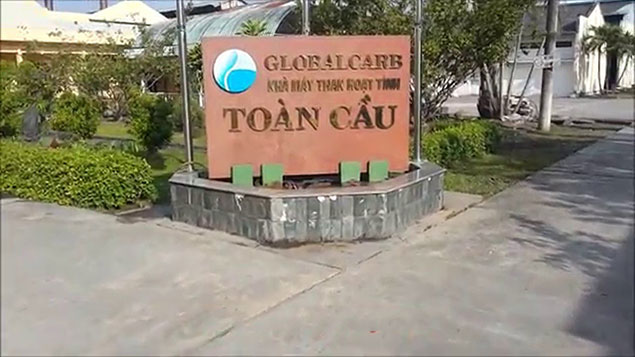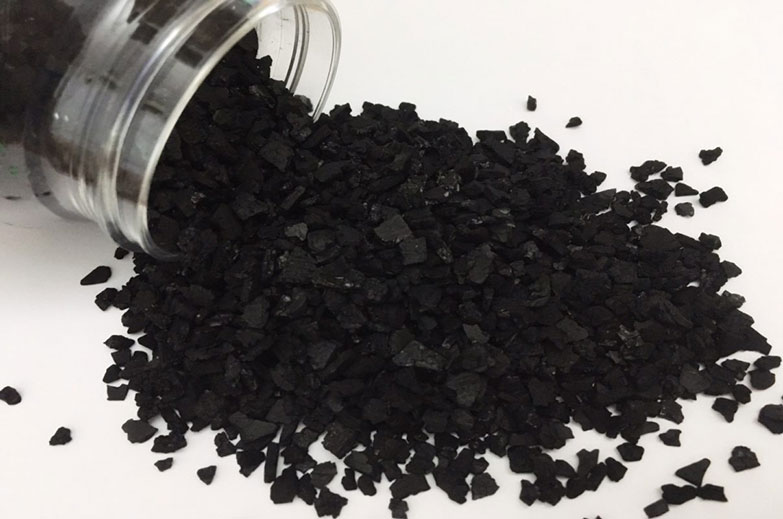1. Concept of activated carbon
What is activated carbon ?: There are many different definitions of activated carbon. However, to understand the most simple way, activated carbon is a product made from materials containing high carbon content such as: coconut skulls, rice husks, bamboo, coal … Treatment (through the activation process) will produce a coal product with a large surface pore structure to serve various tasks in life and called activated carbon.
2. The mechanism of action of activated carbon
The mechanism of action of activated carbon consists of 2 stages: crude filtration and adsorption. In the first stage, large impurities and organic substances are retained on the coal surface because they are larger than the diameter of the pore surface.
The next stage is the adsorption stage, small organic molecules, heavy metal ions are adsorbed onto the surface of the pore system according to the filling mechanism, so the impurities, big or small, when Passing through activated carbon are retained thoroughly.
Based on this mechanism, people have researched and applied activated carbon to many fields in life as well as in industrial production.
3. Applications of activated carbon
Since ancient times, activated carbon has been used by humans. The first activated carbon was used by Egyptians and Sumerians in 3750 BC, before the Pharaoh Tutankhamun (ruled 1332-1323 BC), to recover copper, zinc, tin and doped metals. substances in copper production.
Around 1500 BC, for the first time activated carbon was used in medicine to treat wounds. Activated carbon is used to deodorize and heal wounds in addition to infections.
The ancient Indians used charcoal (a form of activated carbon but with a low specific surface area) to filter drinking water. During World War I, activated carbon was used to make gas masks. Thanks to that, many lives of the soldiers were saved from dangerous poison gas.

Today, thanks to modern production technologies, activated carbon is widely used in many areas of life such as:
3.1. Wastewater treatment
Activated carbon is used to treat polluted water from factories, factories, hospitals, schools, etc.These wastewater sources often contain a large amount of organic waste, which when decomposed will cause ambient pollution and very unpleasant smell.
After being treated through activated carbon, these organic substances will be absorbed into the coal, the wastewater will no longer stink as well as ensure environmental sanitation standards.
- Applications in water treatment wells
- Application of industrial wastewater treatment
3.2. Remove heavy metal
Wastewater from a number of industries contains a large amount of heavy metals such as Hg, Cd, Pb, As, Sb, Cr, Cu, Zn, Mn. If these metals are not completely removed, they will enter the water. Some can cause serious illnesses, others can reduce the quality of life.
? Humans as well as animals, if drinking water with heavy metals for a long time will cause the amount of toxin to build up and create many types of illness. Activated carbon has the ability to absorb many heavy metals and allows the recovery of these metals after absorption.
3.3. Application in chemical technology
Activated carbon can be used as a catalyst for many chemical processes, or used as a raw material, carrier, biological environment for many other processes.
Medical applications: Activated carbon is used in the treatment of food poisoning as well as in the manufacture of many medicines and pharmaceuticals such as: in the composition of Carbogast to treat stomach and intestinal pain, Carbotrim treats bacterial infections and food poisoning.
Making filter materials:Activated carbon is used to filter water for daily use. Currently, activated carbon is used in most popular water filtration systems on the market. In addition, activated carbon is also used for air purification, bactericidal and application in air conditioning systems, used in cigarette filters, in gas masks.
3.4. Industry in mining industry
Using activated carbon to extract gold, silver and other precious metals is a new and very effective technology.
3.5. In the cosmetics industry
With the ability to clean, suck impurities, tighten pores and remove excess alkaline harmful to the skin, activated carbon can be used to make masks for white skin, used in toothpaste , as well as activated carbon soap.
4. Types of activated carbon on the market today
On the market today, there are many types of activated carbon, making it difficult for users to choose which products to suit the needs and purposes of use. Based on the purpose of use, raw materials and production process, activated carbon is divided into 4 main types.

Granular activated carbon is a type of coal produced from coconut shell material by activation method at the temperature of 900 to 10000 C. With the nature of a large surface area, granular activated carbon is applied. widely in the fields of: Filtering water, air purifying, deodorizing … for more details, you can see more article: Granular activated carbon and practical applications
Powder activated carbon: A fine powdered coal, commonly used to treat synthetic chemicals such as chemical spills. In addition, this is also the main raw material used in the cosmetics industry. For more details, you can refer to the informationhere:
Activated carbon in tablet and tablet form:This type of coal is cylindrical or cubic, commonly used in domestic and industrial water filtration tanks. See details of the applications of activated carbon pelletshere.
Activated carbon in sheets: is the coal made from forming frames and sponge pads soaked in coal powder. This is a very popular product in the field of air purification, deodorizing. See the applications of activated carbon membershere
5. Raw materials for production of activated carbon

Because the main component of activated carbon is Carbon, all sources of Carbon-rich materials can be used to create activated carbon. Currently, activated carbon is produced from the main raw materials such as:
Coal: As you know, coal is one of the fossil raw materials with the main component is Carbon. The coal is formed by the plants buried in the swamp, and over the course of about 300 million years, the trees gradually change and form coal. Because carbon is the main ingredient, this is the source of raw materials for the production of activated carbon.
Petroleum products: Activated carbon can be produced from petroleum products such as asphalt, alkane, aromatic carbon. These are all carbon-rich materials that can be used as input materials in the production of activated carbon.
Bamboo, firewood, peanut shells, husks, coconut shells: These are plant-based materials that contain large amounts of carbon and are a good source of raw materials for the production of activated carbon. Not only that, for components such as rice husk (As the grain of the grain), peanut shell, coconut shell (As coconut shell) are all discarded materials, when reused to produce activated carbon. will create more income for farmers, reduce environmental pollution.
The aforementioned materials are high in carbon content, but the main raw material for the production of activated carbon currently mainly uses coconut shells because this is a material that is widely grown in our country and activated carbon products Coconut is better than other types of activated carbon.
6. Technology process for activated carbon production
With the old technology, in order to produce the activated carbon the final product needs two steps: the process of coalization and the process of activation. However, the method of making activated carbon by this technology will not guarantee the output for the best quality product because during transportation, it is often contaminated and impurities.
Currently with the latest technology, the process of producing activated carbon is only 1 stage, which is to bring the raw materials into the furnace. This furnace will handle both coalization and activation processes seamlessly and consistently to produce the best quality products.
You can find out the article about the process of producing activated carbon of Global company to better understand the technology and production method.

7. Which company produces active charcoal Vietnam prestige?
Currently, activated carbon Vietnam has been exported a lot through the world such as Japan, America, European countries. . and get very good feedback on the quality. Leading in the field of activated carbon production in Vietnam, our Global Activated Carbon Company is committed to providing our customers with quality products and competitive prices in Vietnam.

Global Activated Carbon Company – photos
In addition, to visit the company, you will be visiting the largest production base in Vietnam with the most modern equipment. In addition, you will be consulted by our staff dedicated to your needs and purpose of using activated carbon.
Contact details:
INVESTMENT CONSTRUCTION & EXPLOIT DEVOLUTION TECHNOLOGY JOINT STOCK COMPANY
Phone number: 0988082723
Fax: 0103070746
Email: ctcpdautuxaydung@gmail.com

